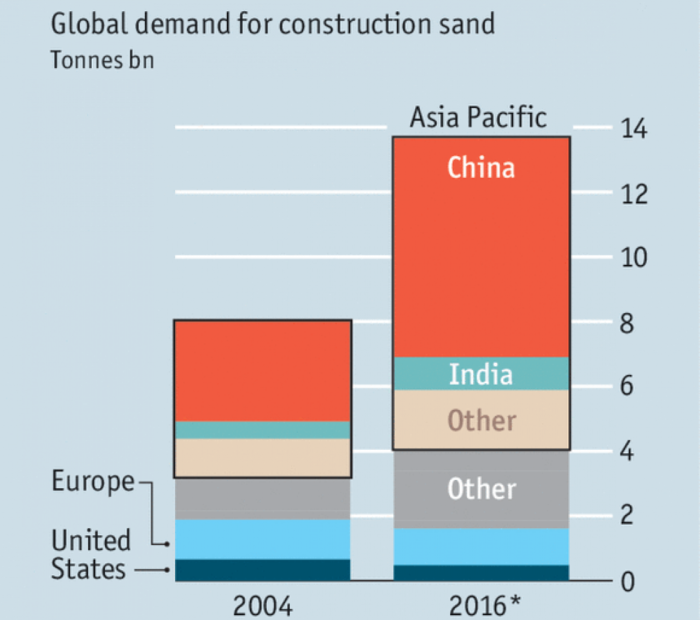1
A cursory glance of existent literature gauging the frequency and impact of environmental disasters on riverine settlements reveals worrying trends. These localities –transcending national divides – have become increasingly prone to crippling flash floods, accelerated soil erosion and dwindling groundwater levels. Scholars proportion significant blame for such anomalies on river sand mining, a flourishing and often unregulated industry. This article provides a succinct overview of the origins of river sand mining, and outlines international policy measures that could be enacted to curb its hazardous ramifications.
The rise of wanton river sand mining is linked to rapid urbanization experienced through much of the post-World War era. As new urban sites continue to emerge, the demand for sand (a construction necessity) exponentially increased. River sand was preferred for construction as it contains a higher moisture content, a desired quality for concrete production. Today, mushrooming demand is being primarily serviced through illicit riverbank extraction sites that harbor minimal concern for the domestic environment. These sites rarely possess regulatory permits from Environmental Agencies as extractors wield immense political clout, often leveraged for tacit approval from local authorities. Unfortunately, such operations now function at a global stage and cater to large international projects. For instance, the river banks of Cambodia provide sand for the construction of Singaporean high rises, the flood plains of Malaysia supply sand for Indian infrastructural projects, and mineral sand from Australia serves to fashion concrete jungles of the UAE. If such unsustainable practices are not addressed, it is bound to exacerbate environmental degradation and therein precipitate into a humanitarian crisis.

Currently, regulations pertaining to such mining practices are rarely coordinated on an international scale but instead are primarily implemented by domestic authorities. Thus, we see pendular shifts in emphasis amongst States. While some States, such as Cambodia, have taken the issue in stride, others, like Colombia, have placed it in the back burner. Not surprisingly, such unilateral approaches are found to be deficient: Cambodia’s experiences serve as an example. The enactment of an embargo on sand exports earlier this year did initially result in an abatement of extraction but recent estimates deduce that the conditions are gradually reverting. Given that most sites are operated illicitly (perpetuated through graft), the extracted resource is shifted between borders through subterfuge with ease.
International coordination is therefore a vital cog in regulatory mechanisms addressing river sand mining. The effectiveness of coordination is however congruent upon strategies listed and participants mobilized. It is the writer’s opinion that current priority strategies and participants are insufficient to address the issue. The contemporary emphasis on merely curtailing supply (of river sand) is unfeasible as it incentivizes the proliferation of a large informal sector that is difficult to regulate. Rather, emphasis needs to also be placed upon demand-centric policies that disincentive river sand consumption.
The writer thus argues that any stratagem to curb this issue needs to involve a task force comprising of representatives from national “Standards Institutions” (for ex. the American Standards Institute and the Standardized Administration of China) the world over. Such Institutions need to be vested with the authority to carefully discuss and enact standardization reforms that charters accountability within the construction sector, in each nation represented. Ideally, this task force should mandate – with State approval – that contractors are required to provide concise details pertaining to the origins of sand sources as a precursor for the issuance of construction permits. This shifts the onus of responsibility on the contractor, who is now forced to ensure that suppliers possess necessary licenses for extraction. Such a strategy will theoretically instigate a vertical transposition of accountability and will thus curb the quantity of illicit sand mined on river banks by a process of increased ‘self-regulation’.
River sand mining is a human act of environmental degradation that requires immediate attention. Innovative policies are required to curb this issue, and the writer believes that a demand centric policy – as explained above – is a necessity to curb the adverse impacts of such practices.
VS